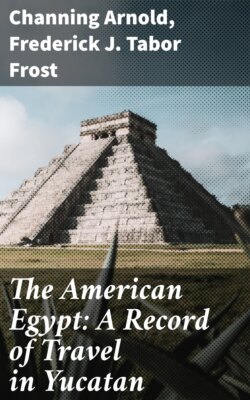Читать книгу The American Egypt: A Record of Travel in Yucatan - Frederick J. Tabor Frost - Страница 3
PREFACE
ОглавлениеIn publishing the present volume, it is our privilege to produce the first book ever written by Englishmen on Yucatan—that Egypt of the New World, where, it is now generally admitted, Central American Civilisation reached its apogee—and to be, for the present at least, the only Englishmen who can claim to have explored the uncivilised north-eastern portions of the Peninsula and the islands of her eastern coast. Mr. A. P. Maudslay, who in 1889 made a lengthy stay at and a detailed survey of Chichen, has done yeoman service to Central American archæology by his years of patient work (alas! too little appreciated) in Guatemala, in the Usumacinta district and Southern Mexico.
Work, and wonderful work, has been done in civilised Yucatan by bands of earnest labourers from the States, from Germany, and from France. Among these the most notable is the late J. L. Stephens, the American traveller, who visited Yucatan in 1842, and who is justly regarded as the Father of Mayan archæology. In his footsteps has followed, during recent years, Mr. Edward H. Thompson, one of the most painstaking and accomplished of American archæologists. France has been represented by M. Desiré Charnay, and latterly by Count Perigny. Of the German field-workers the most assiduous have been Professor Seler, T. Maler, and K. Sapper; while all who wish to see the Mayan problem solved must pay a meed of thanks to the eminent Professor Forstemann for his attempts to decipher the inscriptions, even if they feel, as do we, that he has allowed his enthusiasm to lead him too far astray on a will-o'-the-wisp path of inquiry and theory.
The problem reviewed in this volume is a profoundly interesting one. The ethnology of the Americas presents a problem as yet unsolved. The average ethnologist has been content to label the vast affiliated hordes and tribes of the two Americas "Mongolian." But the American ethnological puzzle is deepened by the existence of what is known as the Mayan civilisation and its many ramifications throughout Central America. Whence came these building races? What cradle-land is one to assign to architects whose achievements often rival in grandeur the monuments of Egypt? How is one to believe that they were ordinary members, or members at all, of that great affiliated race of American Indians whose ideas of building were represented in the north by the snow-house of the Eskimo and the wigwam of the Sioux, and in the south by the leaf-shelters of the cannibal inhabitants of the forests of Brazil?
In the later chapters of this volume we endeavour to analyse the evidence which we and others have collected on this thorny Mayan problem. We cannot too strongly urge that the time has come to drop once and for all the Toltec theory. We know that we are thus taking up a position in direct opposition to four-fifths of the students and scholars who have worked in the field; but we are as convinced that the race which built the ruined palaces and temples of Yucatan is not a vanished race as we are convinced that the Toltec theory is a gross error.
And if we are obstinate as to the origin of Mayan civilisation, we fear we must be charged, too, with gross obstinacy in the matter of deciding the age of the ruins. We would like to believe, with those more sanguine, that the wonderful structures have a history rivalling Memphis or Syene. But we cannot believe it, and we hope that those who read this volume will acquit us of coming to this very disappointing decision on flimsy grounds. In such matters no grounds but practical ones are to be trusted, and we claim that an expert builder's careful examination of the ruins, after due allowance is made for the friability of the limestone used in such a climate as Yucatan enjoys, will prove to any open-minded inquirer that the oldest building still standing, so to speak, intact, has not seen more than six centuries.
In the present volume it has been impossible to do more than "open the case" for the theory we propound, viz. that America's first architects were Buddhist immigrants from Java and Indo-China. To attempt to prove this would require much time and money; but, alas! archæology is not such a popular and paying science as will allow those without large means at their disposal to follow up their theories.
We should need many months of careful study in Java, the Malay Peninsula, Ceylon and India. If investigations there proved satisfactory, the next step would be to follow the route we have suggested as that taken by the migrators in a vessel as similar as possible to those it may be presumed they employed. Along the route a more minute study of the archæological remains on the islands of the Caroline and Marshall groups than has yet been undertaken could be made. Thence the voyage would be continued to the American mainland, where a thorough investigation of the country between the coast and Copan would probably yield valuable data. But such an expedition would require an outlay of thousands of pounds and would occupy two or three years, much of which would have to be spent under such hardships as only enthusiasts could contemplate.
C. A.
F. J. T. F.
London, 1908.
